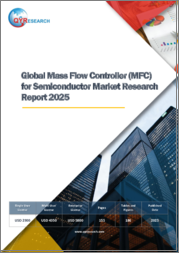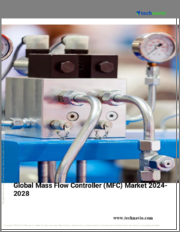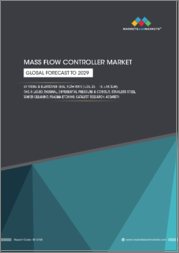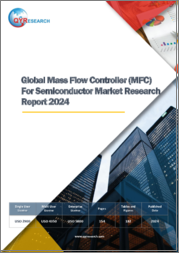
|
시장보고서
상품코드
1504168
질량 유량 컨트롤러 시장 규모, 점유율, 예측 및 동향 분석 : 제품 유형, 유량, 최종 사용자 및 지역별 - 세계 예측(-2031년)Mass Flow Controllers Market Size, Share, Forecast, & Trends Analysis by Product Type, Flow Rate, End User (Residential & Commercial, Industrial ), and Geography - Global Forecast to 2031 |
||||||
질량 유량 컨트롤러 시장은 2024-2031년간 9.2%의 연평균 복합 성장률(CAGR)로 성장하여 2031년에는 29억 달러에 달할 것으로 예상됩니다.
이 조사 보고서는 주요 5개 지역의 주요 5개 지역의 질량 유량 컨트롤러 시장을 상세하게 분석하여 현재 시장 동향, 시장 규모, 시장 점유율, 최근 동향 및 2031년까지의 예측을 정리했습니다.
질량 유량 컨트롤러 시장의 성장은 산업 자동화 수요의 급증, 재생 가능 에너지 용도의 연료전지에 대한 질량 유량 컨트롤러 채택 증가, 반도체 제조 산업을 촉진하는 정부 이니셔티브 증가로 인해 발생할 수 있습니다. 그러나 높은 초기 투자비용은 이 시장의 성장을 저해하는 요인으로 작용할 수 있습니다.
또한, 제약 및 의료기기 산업에서 질량 유량 컨트롤러에 대한 수요 증가와 센서 기술의 발전은 시장 이해 관계자들에게 성장 기회를 제공할 것으로 예상됩니다. 그러나 질량 유량 컨트롤러의 차압 제한은 시장 성장에 영향을 미치는 주요 과제입니다.
목차
제1장 시장 정의와 범위
제2장 조사 방법
제3장 주요 요약
제4장 시장 인사이트
- 개요
- 성장 촉진요인
- 성장 억제요인
- 기회
- 과제
- 사례 연구
- Porter의 Five Forces 분석
제5장 질량 유량 컨트롤러 시장 : 제품 유형별 평가
- 개요
- 서멀 질량 유량 컨트롤러
- 코리올리식 질량 유량 컨트롤러
- 차압 질량 유량 컨트롤러
제6장 질량 유량 컨트롤러 시장 : 기술별 평가
- 개요
- 저(0-50 slpm)
- 중(0-300 slpm)
- 고(0-1500 slpm)
제7장 질량 유량 컨트롤러 시장 : 최종사용자별 평가
- 개요
- 주택·상업
- 산업용
- 반도체
- 화학
- 석유 및 가스
- 식품 및 음료
- 제약
- 금속 및 광업
- 상하수도
- 농업
- 기타 산업
제8장 질량 유량 컨트롤러 : 지역별 시장
- 개요
- 북미
- 미국
- 캐나다
- 유럽
- 독일
- 영국
- 프랑스
- 이탈리아
- 스페인
- 네덜란드
- 기타 유럽
- 아시아태평양
- 일본
- 중국
- 인도
- 한국
- 기타 아시아태평양
- 라틴아메리카
- 멕시코
- 브라질
- 기타 라틴아메리카
- 중동 및 아프리카
- 아랍에미리트(UAE)
- 이스라엘
- 기타 중동 및 아프리카
제9장 경쟁 분석
- 개요
- 주요 성장 전략
- 경쟁 벤치마킹
- 경쟁 대시보드
- 업계 리더
- 시장 차별화 요인
- 선행 기업
- 신규 기업
- 시장 점유율 분석
제10장 기업 개요
- Brooks Instrument
- MKS Instruments, Inc.
- HORIBA, Ltd.
- Bronkhorst High-Tech BV
- Christian Burkert GmbH & Co. KG
- Sierra Instruments, Inc.
- Sensirion AG
- Hitachi Metals, Ltd.
- Teledyne Hastings Instruments
- Parker Hannifin Corp
- Alicat Scientific, Inc
- FLSmidth A/S
- Advitech Inc.
- FCON Co., Ltd.
- Azbil Corporation
(주 : 주요 5개사의 SWOT 분석을 제공 예정)
제11장 부록
LSH 24.07.09Mass Flow Controllers Market by Product Type (Thermal, Coriolis, Differential Pressure), Flow Rate (Low, Medium, High), End User (Residential & Commercial, Industrial (Semiconductor, Chemical, Pharmaceutical)), and Geography-Global Forecast to 2031.
The research report titled 'Mass Flow Controllers Market by Product Type (Thermal, Coriolis, Differential Pressure), Flow Rate (Low, Medium, High), End User (Residential & Commercial, Industrial (Semiconductor, Chemical, Pharmaceutical)), and Geography-Global Forecast to 2031' provides an in-depth analysis of mass flow controllers market in five major geographies and emphasizes on the current market trends, market sizes, market shares, recent developments, and forecasts till 2031.
The mass flow controllers market is projected to reach $2.9 billion by 2031, at a CAGR of 9.2% from 2024 to 2031.
The growth of the mass flow controllers market is driven by the surge in demand for industrial automation, increasing adoption of mass flow controllers in fuel cells for renewable energy applications, and increasing government initiatives to boost the semiconductor manufacturing industry. However, the high initial investment may restrain the growth of this market.
Furthermore, the increasing demand for mass flow controllers in the pharmaceutical and medical devices industries and advancements in sensor technology are expected to generate growth opportunities for the market's stakeholders. However, differential pressure limitations with mass flow controllers are a major challenge impacting the market's growth.
The mass flow controllers market is segmented by product type (thermal mass flow controllers, Coriolis mass flow controllers, differential pressure mass flow controllers), flow rate (low (0-50 slpm), medium (0-300 slpm), high (0-1500 slpm)), end user (residential & commercial, industrial (semiconductor, chemical, oil & gas, food & beverage, pharmaceutical, metal & mining, water & wastewater, agriculture, other industries)). The study also evaluates industry competitors and analyzes the market at the regional and country levels.
Based on product type, the mass flow controllers market is segmented into thermal mass flow controllers, Coriolis mass flow controllers, and differential pressure mass flow controllers. In 2024, the thermal mass flow controllers segment is expected to account for the largest share of above 48% of the mass flow controllers market. The large market share of this segment is attributed to the increasing use of thermal MFCs in the chemical, semiconductor, and pharmaceutical industries, advancements in sensor technologies, and increasing focus on reducing costs. Thermal MFCs offer various benefits over other MFCs, such as affordability and simpler design, allowing for easier integration.
However, the pressure mass flow controllers segment is projected to register the highest CAGR during the forecast period. The segment's growth is attributed to the increasing demand for low differential pressure MFCs, which offer faster response and better accuracy than other MFCs, and the increasing use of differential pressure MFCs across various industries.
Based on flow rate, the mass flow controllers market is segmented into low (0-50 slpm), medium (0-300 slpm), and high (0-1500 slpm). In 2024, the low (0-50 slpm) segment is expected to account for the largest share of above 45% of the mass flow controllers market. The large market share of this segment is attributed to the growing trend towards more affordable thermal MFCs and increasing use of low flow rate MFCs in semiconductor manufacturing.
However, the medium (0-300 slpm) segment is projected to register the highest CAGR during the forecast period. The segment's growth is attributed to the increasing emphasis on automation and centralized control systems in various industries and increasing demand for medium flow rate MFCs in chemical processing and food & beverage production applications.
Based on end user, the mass flow controllers market is segmented into residential & commercial and industrial. In 2024, the industrial segment is expected to account for the largest share of above 80% of the mass flow controllers market. The large market share of this segment is attributed to the increasing industrial automation, strict environmental regulations pushing industries to adopt cleaner technologies, increasing demand for low flow rate MFCs in the industrial sector, and advancements in MFC technology such as miniaturization and sensor technology. In June 2022, Sensirion AG (Switzerland) launched the SFC5500 series with four new mass flow controllers and meters for analytical, medical, and industrial applications. Moreover, this segment is also projected to register the highest CAGR during the forecast period.
Based on geography, the mass flow controllers market is segmented into North America, Europe, Asia-Pacific, Latin America, and Middle East & Africa. In 2024, Asia-Pacific is expected to account for the largest share of above 37% of the mass flow controllers market. The market growth in Asia-Pacific is driven by the increasing government initiatives to boost the semiconductor manufacturing industry in the region, Industry 4.0 practices, strict environmental regulations to adopt cleaner technologies, and rising demand for cost-effective thermal MFCs in the region. China is a leader in the region for MFC adoption due to its booming manufacturing sector and government initiatives promoting technological advancements. India is rapidly expanding its manufacturing base and increasingly focusing on automation and process control, increasing the market growth. In September 2023, Brooks Instrument (U.S.) opened a new manufacturing facility for producing mass flow controllers (MFCs) in Penang, Malaysia. Moreover, this region is also projected to record the highest CAGR of above 10.5% during the forecast period.
The key players operating in the mass flow controllers market are Brooks Instrument (U.S.), MKS Instruments, Inc. (U.S.), HORIBA, Ltd. (Japan), Bronkhorst High-Tech BV (Netherlands), Christian Burkert GmbH & Co. KG (Germany), Sierra Instruments, Inc. (U.S.), Sensirion AG (Switzerland), Hitachi Metals, Ltd. (Japan), Teledyne Hastings Instruments (U.S.), Parker Hannifin Corp (U.S.), Alicat Scientific, Inc (U.S.), FLSmidth A/S (Denmark), Advitech Inc. (U.S.), FCON Co., Ltd. (Japan), and Azbil Corporation (Japan).
Key Questions Answered in the Report:
- What are the high-growth market segments in terms of the product type, flow rate, and end user?
- What is the historical market size for the mass flow controllers market?
- What are the market forecasts and estimates for 2024-2031?
- What are the major drivers, restraints, opportunities, challenges, and trends in the mass flow controllers market?
- Who are the major players in the mass flow controllers market, and what are their market shares?
- What is the competitive landscape like?
- What are the recent developments in the mass flow controllers market?
- What are the different strategies adopted by major market players?
- What are the trends and high-growth countries?
- Who are the local emerging players in the mass flow controllers market, and how do they compete with other players?
Scope of the Report:
Mass Flow Controllers Market Assessment-by Product Type
- Thermal Mass Flow Controllers
- Coriolis Mass Flow Controllers
- Differential Pressure Mass Flow Controllers
Mass Flow Controllers Market Assessment-by Flow Rate
- Low (0-50 slpm)
- Medium (0-300 slpm)
- High (0-1500 slpm)
Mass Flow Controllers Market Assessment-by End User
- Residential & Commercial
- Industrial
- Semiconductor
- Chemical
- Oil & Gas
- Food & Beverage
- Pharmaceutical
- Metal & Mining
- Water & Wastewater
- Agriculture
- Other End Users
Mass Flow Controllers Market Assessment-by Geography
- North America
- U.S.
- Canada
- Europe
- Germany
- U.K.
- France
- Italy
- Spain
- Netherlands
- Rest of Europe
- Asia-Pacific
- Japan
- China
- India
- South Korea
- Rest of Asia-Pacific
- Latin America
- Mexico
- Brazil
- Rest of Latin America
- Middle East & Africa
- UAE
- Israel
- Rest of Middle East & Africa
TABLE OF CONTENTS
1. Market Definition & Scope
- 1.1. Market Definition
- 1.2. Currency & Limitations
- 1.2.1. Currency
- 1.2.2. Limitations
2. Research Methodology
- 2.1. Research Approach
- 2.2. Data Collection & Validation Process
- 2.2.1. Secondary Research
- 2.2.2. Primary Research/Interviews with Key Opinion Leaders from the Industry
- 2.3. Market Sizing and Forecasting
- 2.3.1. Market Size Estimation Approach
- 2.3.2. Growth Forecast Approach
- 2.4. Assumptions for the Study
3. Executive Summary
- 3.1. Overview
- 3.2. Market Analysis, By Product Type
- 3.3. Market Analysis, By Flow Rate
- 3.4. Market Analysis, By End User
- 3.5. Market Analysis, By Geography
- 3.6. Competitive Analysis
4. Market Insights
- 4.1. Overview
- 4.2. Factors Affecting Market Growth
- 4.2.1. Drivers
- 4.2.1.1. Surge in Demand for Industrial Automation
- 4.2.1.2. Increasing Adoption of Mass Flow Controllers in Fuel Cells for Renewable Energy Applications
- 4.2.1.3. Increasing Government Initiatives to Boost Semiconductor Manufacturing Industry
- 4.2.2. Restraints
- 4.2.2.1. High Initial Investment
- 4.2.3. Opportunities
- 4.2.3.1. Increasing Demand for Mass Flow Controllers in Pharmaceutical and Medical Devices Industries
- 4.2.3.2. Advancements in Sensor Technologies
- 4.2.4. Challenges
- 4.2.4.1. Differential Pressure Limitations with Mass Flow Controllers
- 4.2.1. Drivers
- 4.3. Case Studies
- 4.4. Porter's Five Forces Analysis
5. Mass Flow Controllers Market Assessment-by Product Type
- 5.1. Overview
- 5.2. Thermal Mass Flow Controllers
- 5.3. Coriolis Mass Flow Controllers
- 5.4. Differential Pressure Mass Flow Controllers
6. Mass Flow Controllers Market Assessment-by Technology
- 6.1. Overview
- 6.2. Low (0-50 slpm)
- 6.3. Medium (0-300 slpm)
- 6.4. High (0-1500 slpm)
7. Mass Flow Controllers Market Assessment-by End User
- 7.1. Overview
- 7.2. Residential & Commercial
- 7.3. Industrial
- 7.3.1. Semiconductor
- 7.3.2. Chemical
- 7.3.3. Oil & Gas
- 7.3.4. Food & Beverage
- 7.3.5. Pharmaceutical
- 7.3.6. Metal & Mining
- 7.3.7. Water & Wastewater
- 7.3.8. Agriculture
- 7.3.9. Other Industries
8. Mass Flow Controllers Market-by Geography
- 8.1. Overview
- 8.2. North America
- 8.2.1. U.S.
- 8.2.2. Canada
- 8.3. Europe
- 8.3.1. Germany
- 8.3.2. U.K.
- 8.3.3. France
- 8.3.4. Italy
- 8.3.5. Spain
- 8.3.6. Netherlands
- 8.3.7. Rest of Europe
- 8.4. Asia-Pacific
- 8.4.1. Japan
- 8.4.2. China
- 8.4.3. India
- 8.4.4. South Korea
- 8.4.5. Rest of Asia-Pacific
- 8.5. Latin America
- 8.5.1. Mexico
- 8.5.2. Brazil
- 8.5.3. Rest of Latin America
- 8.6. Middle East & Africa
- 8.6.1. UAE
- 8.6.2. Israel
- 8.6.3. Rest of Middle East & Africa
9. Competition Analysis
- 9.1. Overview
- 9.2. Key Growth Strategies
- 9.3. Competitive Benchmarking
- 9.4. Competitive Dashboard
- 9.4.1. Industry Leaders
- 9.4.2. Market Differentiators
- 9.4.3. Vanguards
- 9.4.4. Emerging Companies
- 9.5. Market Share Analysis
10. Company Profiles
- 10.1. Brooks Instrument
- 10.2. MKS Instruments, Inc.
- 10.3. HORIBA, Ltd.
- 10.4. Bronkhorst High-Tech BV
- 10.5. Christian Burkert GmbH & Co. KG
- 10.6. Sierra Instruments, Inc.
- 10.7. Sensirion AG
- 10.8. Hitachi Metals, Ltd.
- 10.9. Teledyne Hastings Instruments
- 10.10. Parker Hannifin Corp
- 10.11. Alicat Scientific, Inc
- 10.12. FLSmidth A/S
- 10.13. Advitech Inc.
- 10.14. FCON Co., Ltd.
- 10.15. Azbil Corporation
(Note: SWOT Analysis of the Top 5 Companies Will Be Provided)
11. Appendix
- 11.1. Available Customization
- 11.2. Related Reports



















